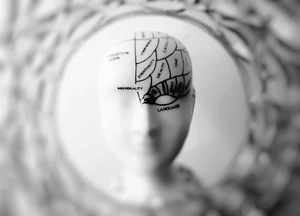A deeper understanding of how the brain works even when resting is important for the diagnosis and prevention of both neurological and sleep disorders, she says.
Cerebral cortex mapping: a bridge between science and clinical practice
Research on the parcelling of the cerebral cortex dates to the early 20th century, when German neuroscientist Korbinian Brodmann defined 52 distinct areas of the human cerebral cortex, known as Brodmann areas. This map of the cerebral cortex is still widely used in both clinical practice and neuroscience research.
According to Dr Armonaitė, distinguishing between the cortex and other structures in the brain allows specific areas to be linked to specific functions, such as vision, language, motor skills or long-term memory storage. Knowing which areas are responsible for certain behavioural or sensory aspects can help to better understand how different neurological disorders affect these functions.
“For example, Parkinson’s disease is often associated with degeneration of the substantia nigra, a structure in a deep area of the brain that is responsible for controlling movement. Damage to this area leads to typical symptoms of the disease, such as tremors or slowness of movement,” says the researcher.
If we know how a healthy brain should behave, we can look for deviations from this normal pattern, which can help us detect the disease before it shows clear symptoms.
She explains that the precise identification of the affected area of the brain allows the planning of targeted interventions, such as neurostimulation, which has been successfully used to reduce the symptoms of the disease. “Another example is the identification of the epilepsy focus. Knowing which area of the brain is causing seizures and what functions it performs allows doctors to more precisely plan an intervention to remove the focal area and assess the potential risks and impact on the patient afterwards,” says the researcher from KTU’s Faculty of Mathematics and Natural Sciences.
She explains that the distinction between brain regions is also important for building models of brain activity, for studying the effects of psychiatric diseases on different brain regions, or for understanding why certain symptoms occur in the presence of specific lesions.
“In addition, brain-computer interfaces also rely on precise localisation of neural activity,” says Armonaitė.
Unique computational methods discovered
The KTU researcher’s study analysed intracranial electroencephalogram (sEEG) recordings from 55 patients. “These signals are taken directly from the brain rather than the scalp. Such data is extremely rare because it is only collected when patients undergo neurosurgical intervention, typically for drug-resistant epilepsy,” explains Dr Armonaitė.
To understand whether different cortical areas transmit information differently and why, she started by analysing the neurophysiological signals from the most clearly defined areas – sensory, motor and auditory – whose functions have been studied most.
“We often hear about neurodegenerative disorders and the search for their biomarkers to make an early diagnosis. But the question that interested me the most was: how does the healthy brain function? And can we detect its activity markers while at rest? After all, even in the absence of external stimuli, the brain remains active. It’s not just chaotic noise, but rather a lot of encoded information in the electrical signals transmitted between neurons,” says Armonaitė.
The research has led to the discovery of computational methods that, according to the KTU researcher, make it possible to refine the parcelling of the brain cortex according to the electrical activity of different regions.
“Now it would be interesting to go even further – for example, to create models of brain activity based on certain features of these areas and apply them to detect very early abnormalities, such as incipient neurodegenerative processes. Also, the markers of healthy cortical areas of the brain, observed during sleep, could be compared with data from patients with sleep disorders,” says Armonaitė.
Clinical potential in the diagnosis of sleep and neurodegenerative disorders
Although the study does not yet have a direct clinical application, it opens many theoretical possibilities, says the KTU neuroscientist. For example, further research could lead to the creation of digital models of cortical areas, their digital twins. Knowing the cell structure, interactions and electrical parameters, it would be possible to simulate how such an area would react to, for example, electrical stimulation. “This could eventually contribute to the development of personalised neurological therapies,” says Armonaitė.
One practical application of research on the human brain at rest could be the diagnosis of sleep disorders, she said. While most methods assess sleep in a rather generalised way, a detailed study of the activity of cortical areas could help to identify more precisely which areas of the brain function differently and why.
“This is relevant because sleep, although it may seem like a passive state, is a very dynamic process, involving consolidation of information, metabolic cleaning, and reorganisation of synapses,” explains the researcher. “Subtle changes in neural activity during sleep may also indicate the onset of neurodegenerative processes.”
If we know how a healthy cerebral cortex should behave in different states or functional tasks, she says, we can look for deviations from this normal pattern, which can help us detect the disease before it shows clear symptoms. In addition to early diagnosis and prevention, this would also contribute to a deeper understanding of the mechanism of the diseases themselves.
The study described above is published in the scientific journal Physica D: Nonlinear Phenomena and can be accessed here.



